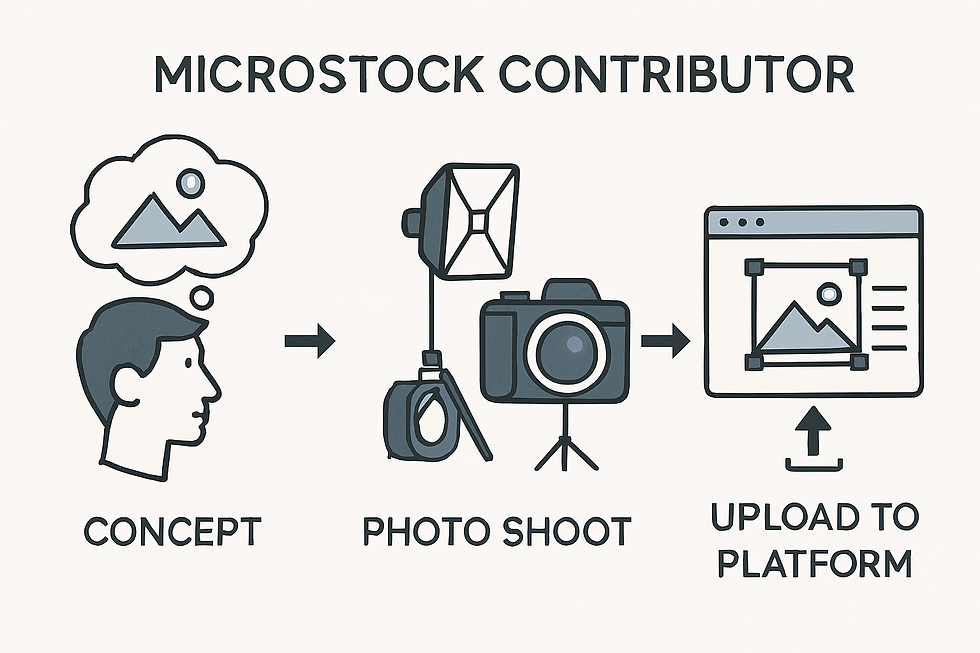Microstock Market Saturation Analysis: Trends, Challenges & Opportunities
- Nikhil Garg
- Aug 10
- 5 min read
Introduction
The microstock photography industry has undergone massive changes over the past decade, evolving from a high-demand, high-growth market to one facing intense competition. With millions of new files uploaded each month to platforms like Shutterstock, Adobe Stock, and iStock, contributors are asking the big question: Has the microstock market become saturated?
This blog delivers a comprehensive microstock market saturation analysis for 2025–2026, exploring trends, challenges, and opportunities. We’ll look at why saturation happens, how AI impacts supply and demand, and what strategies contributors can use to stand out in an increasingly crowded space.

1. What is Market Saturation in Microstock?
Market saturation happens when supply outweighs demand, making it harder for contributors to get sales. In microstock, this means:
Thousands of similar images in the same category
Declining sales per image
Higher competition for top search rankings
Example: Uploading yet another "smiling business team" photo in 2025 is unlikely to gain traction because buyers already have countless similar options.

2. Why the Microstock Market is Saturated
Several factors drive saturation:
Mass Uploading – Contributors and agencies uploading thousands of images monthly.
AI-Generated Content – Inexpensive and fast to produce, flooding the market.
Low Entry Barriers – Anyone with a camera or AI tool can contribute.
Repetitive Concepts – Overproduction of generic themes like coffee cups, laptops, and handshake photos
3. AI’s Double-Edged Sword in Saturation
AI is both a culprit and a solution:
Culprit: AI tools like Midjourney and DALL·E allow contributors to create hundreds of images a day, quickly saturating keywords.
Solution: The same AI tools can help contributors explore new, untapped concepts faster.
The trick is using AI to create unique perspectives rather than replicating overused ones.

4. Data Insights: What’s Overcrowded?
Based on current trends, these categories are highly saturated:
Business meetings & teamwork shots
Standard travel landmarks (Eiffel Tower, Times Square)
Food flatlays of coffee, pizza, or burgers
Meanwhile, less saturated areas include:
Niche cultural festivals
Emerging tech concepts (quantum computing, green hydrogen)
Hyperlocal travel destinations

5. Survival Strategies in a Saturated Market
To thrive despite saturation:
Niche Down – Focus on specific subjects buyers can’t easily find.
Combine AI + Photography – Hybrid workflows for unique compositions.
Master Metadata – Keyword precisely to match buyer intent.
Create Series – Sets of 10–20 related images to increase chances of multiple sales.

6. The Role of Authenticity
With AI-generated content dominating search results, buyers increasingly crave authenticity. Real, relatable, and culturally accurate images stand out.
Example: A real street food vendor in Mumbai will outperform a generic AI "street food" image.
7. Data-Driven Market Saturation Insights
To understand the depth of microstock saturation, it’s important to look at the numbers. According to industry data:
Shutterstock hosts over 750 million images, with 1.5 million new files uploaded weekly.
Adobe Stock has crossed 450 million assets, with AI-generated content representing an estimated 25–30% of new uploads in 2025.
The average sale per image for contributors has dropped by 15–20% in the last 3 years due to competition.
These figures show the urgency of diversifying your content. The more generic your subject, the more you compete against hundreds of thousands of similar files.

8. Case Studies: Saturated vs. Niche Success
Case 1: Oversaturated Category
A contributor uploads 50 images of "modern office meeting scenes" in 2025. Within 6 months, only 2–3 sales occur. Reason: Buyers already have thousands of similar options, and established portfolios dominate the first search pages.
Case 2: Niche Category
Another contributor uploads a photo series of "local artisans weaving traditional textiles in rural India." Within 3 months, the set sells over 25 times. Reason: Unique subject matter, cultural authenticity, and low competition.
📌 Lesson: In microstock, relevance and uniqueness outweigh sheer quantity.

9. Opportunities in 2026 and Beyond
While saturation is real, the microstock industry isn’t dead—it’s evolving:
Demand for video and vertical content is rising.
Editorial and real-world news images will remain valuable.
Contributors with personal brands will benefit from portfolio-based promotion.

10. Contributor Action Plan for 2026
If you want to survive (and thrive) in a saturated microstock market, here’s your step-by-step strategy:
Audit Your Portfolio
Remove or deprioritize outdated, low-quality, or repetitive images.
Identify your best-selling niches and focus on them.
Research Before You Shoot
Use keyword tools on Shutterstock or Adobe Stock to spot low-competition, high-demand topics.
Look for trends in technology, sustainability, and local culture.
Adopt Hybrid Creation
Blend AI tools with photography to create unique compositions.
Example: Real people + AI-enhanced backgrounds.
Optimize Metadata
Write descriptive, natural titles and captions.
Avoid keyword stuffing—focus on buyer intent.
Diversify Formats
Add vertical videos, motion graphics, or vector illustrations to your portfolio.
Cater to the growing short-form content market.
Build Your Brand Outside Platforms
Use social media to showcase your work.
Create a personal website or Behance portfolio to drive direct buyers.

TL;DR
Microstock is saturated in popular categories like business, travel, and food—but opportunities still exist in underrepresented niches. AI tools are accelerating saturation, but they also enable faster, more creative production. Contributors who focus on authenticity, niche subjects, and hybrid workflows will maintain visibility and earnings.

Conclusion: The Path Forward
Microstock saturation is real—but it’s not the end. Those who adapt with strategic niche targeting, authentic storytelling, and metadata mastery will continue to find success. The microstock landscape in 2026 favors contributors who understand both creativity and platform algorithms.
Whether you’re new or experienced, now is the time to position yourself as a creator of high-value, in-demand content rather than just another uploader in the crowd.
FAQ: Microstock market saturation analysis
Q1. Is the microstock market too saturated to start in 2026?
No—avoid overpopulated categories and focus on unique niches.
Q2. Does AI make saturation worse?
Yes, but it also opens new creative possibilities if used wisely.
Q3. What content types are least saturated?
Niche cultural events, emerging technologies, hyperlocal travel, and vertical videos.
Q4. How can I get more visibility?
Optimize metadata, upload in sets, and maintain consistent quality.
Q5. Should I focus on video instead of photos?
If you can—yes. Video demand is growing faster than image demand
📎 Bonus Resource
👉 Download this FREE PDF guide Packed with actionable tips for Shutterstock success, niche ideas, and automation tools for contributors.




Comments